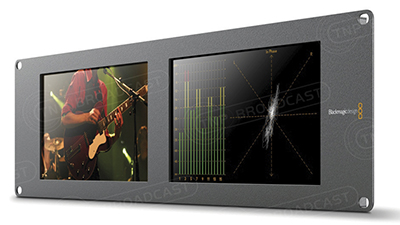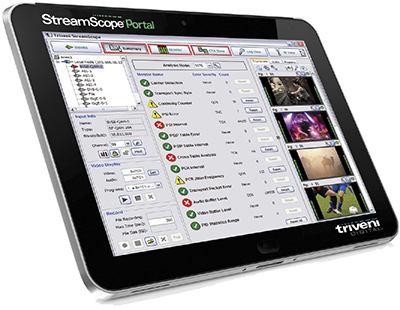Test Equipment Grows to Fit New Niches
ALEXANDRIA, VA.—It doesn’t take long working out in the field to learn that just about everyone has a different definition of what constitutes “the field.” Therefore, an overview of test and measurement equipment used in the field is fairly far ranging, and it might include some gear that also gets used in a studio/control room environment.
With the steady improvement of cameras, recorders and remote equipment over the years, even classic video test equipment such as waveform monitors and vectorscopes are used much less than they used to be for routine field operations. For example, it’s common for a remote news crew never to glance at a waveform monitor in the process of sending video back to the studio for a live broadcast—most crews rely on the camera viewfinder’s “zebra” display to let them know if the video is overexposed.
“New cameras have much more dynamic range and sensitivity, so getting a decent picture is not as hard as it used to be,” said Joey Gill, chief engineer at WPSD-TV in Paducah, Ky. “Most modern cameras do pretty darn good not compressing the whites or blacks.”
One piece of gear that Gill takes to remote shoots is the Harris/Videotek HD-Star test set.
“It’s a handheld color monitor, vectorscope, waveform monitor, test signal generator, embedded audio monitor and serial data analyzer, all in one,” he said. “If a camera doesn’t look right, I just plug it into the HD-Star and I can check waveform and vectors. If there is no embedded audio, I can trace the signal back through the path and see where the audio is disappearing, and it’s invaluable for checking cables and switches for SDI.”
More elaborate field production requires an array of test and measurement devices, including a product that affects practically everything else in the video chain: a sync generator. Tektronix is finding that its SPG8000 sync generator is a popular choice for remote production trucks.
“Highly reliable and stable facility timing is a mission-critical requirement for content creation and content distribution operations to maintain system timing of the facilities,” said Richard Duvall, video marketing manager for Tektronix. “The SPG8000’s optional GPS lock support is ideal for mobile truck and OB van applications, and it also features NTP server capability that serves as a master clock unit for computer-based video equipment.”
Get the TV Tech Newsletter
The professional video industry's #1 source for news, trends and product and tech information. Sign up below.

Blackmagic Design SmartScope DuoA NEW PLAYER
Those same production trucks and OB vans definitely still use waveform monitors and vectorscopes, and in the past couple years, there’s been a new player in that corner of the industry: Blackmagic Design. Bob Zelin, president of Rescue 1, a systems integration company in Orlando, Fla., recently started using Blackmagic’s Ultra- Scope and SmartScope Duo in his projects for reasons he finds obvious.
“Blackmagic UltraScopes were chosen simply because they cost less than similar scopes from the other manufacturers,” Zelin said. “In the future, I will only specify the new Blackmagic SmartScope Duo for my installations.”
Zelin has installed Blackmagic Pocket UltraScopes in the Kavis Production Services 53-foot editing truck that is used for Bellator Fighting Championships and the Barrett-Jackson Automobile Auction.
He’s also installed them in various facilities in Florida, including Disney Broadcast Operations and Adrenaline Films.
“The display on the UltraScope is as good as or better than any rasterizer product from other vendors,” Zelin said. “Although advanced features like lightning display and diamond pattern are not available on the UltraScope, I have found that most technical personnel have no idea how to use those features. The UltraScope offers display modes that are not available on more expensive scopes, such as digital audio metering and audio phase, picture monitor display, and histograph.”
We all know the benefits of digital video, but it’s also clear that testing and monitoring digital video streams requires its own skills and equipment. Rohde & Schwarz’s ETL TV analyzer can be used to keep on top of virtually the entire video signal chain from camera to transmitter.
“I use my ETL TV analyzer anytime I’m at an ATSC broadcast site, whether I’m doing a new install or troubleshooting an operational transmitter,” said Steven Ramer, owner of SJ Ramer Associates, a broadcast consulting company based in Warminster, Pa. “I use all aspects of both the built-in 3 GHz spectrum analyzer and the 8-VSB signal analyzer.”
Ramer is called on to maintain a variety of broadcast facilities and he’s impressed with the Rohde & Schwarz ETL, although he recognizes that it’s not necessarily a product needed by every broadcaster.
“The ETL is a powerful instrument and thus may be a bit much for a single TV station unless used for 24/7 monitoring of a remote transmitter site,” he said. “It is ideal for field or regional engineers at station groups and networks. As a contractor for service, installation and engineering of everything from the encoder to the transmitter, I use the ETL every day.”

Triveni Streamscope PortalMPEG STREAM ERRORS
Digging into the MPEG stream to find errors is a necessary part of life in the DTV world. Triveni Digital just announced its new StreamScope Portal, a portable MPEG stream analyzer that runs on an iPad.
“Many broadcast and cable engineers manage multiple locations simultaneously and need an MPEG measurement tool that can perform real-time MPEG-2/MPEG-4 analysis at the office, onsite, and on the road,” said Ralph Bachofen, vice president of sales and head of marketing at Princeton Junction, N.J.-based Triveni Digital. “Triveni Digital’s tablet-based StreamScope Portal brings the much-needed portability and convenience to MPEG analysis and monitoring.”
Video producers, networks and broadcasters are challenged by complex metadata, audio loudness, ad insertion and encoding issues caused by MPEG errors in the DTV transport stream, according to Bachofen. The StreamScope Portal’s portable design and low cost make it a good choice for troubleshooting DTV transport streams on the go, from any location.
With video now delivered for viewing on anything from smartphones to projection displays, encoding all the necessary resolutions is a significant concern for video creators and distributors. Encode/decode errors cause dropouts in the video and audio, which makes for unhappy viewers.
“Some of the most common data stream errors come from sources that are either encoded improperly or had difficult-to-encode scenes fail to decode at the delivery end,” said Adam Schadle, vice president of sales and marketing for Campbell, Calif.-based Video Clarity. “This can include errors in transmission that delay or fail to deliver packets to the destination that produce buffer under-runs at the decoded video end.”
Schadle said that the video/ audio signal path needs to be more diligently monitored for quality and up-time performance.
“This is important due to the number and types of end-point delivery devices and changing software and hardware versions of network delivery processing devices deployed,” he said. “The whole chain needs continuous benchmarking, or the delivered audio/video quality can degrade or be inconsistently delivered with these changing conditions.”
AUTOMATIC RECORDING
Video Clarity’s solution is its RTM data stream analyzer, which provides automatic datastream recording. “When a user-set threshold is breached of any specific audio or video quality parameter, the RTM records only the offending segment,” Schadle said. “This provides a source vs. destination split-screen reviewable recording that contains the error or errors that occurred in the transmission.”
Pixelmetrix has a range of products that measure and analyze video transmissions, and one of the most interesting is its Electronic Couch Potato, a measurement robot that continually scans each channel in a multi channel system looking for anomalies.
“For any kind of product business— whether television or kiwi fruit—a robust quality control process along the entire delivery chain is vital, and that’s even more true with a fragile product prone to damage in transit [like TV signals or kiwi fruit],” said Danny Wilson, president and CEO of Singapore- based Pixelmetrix. “The financial success of any type of TV operator depends on interesting content delivered with high quality. Like kiwi fruit, even if the product leaves the building in perfect shape, if it’s crushed, bruised and abused when it reaches the supermarket, no one will buy.”
Television is no different.
“Doing regular audits of end-point delivery quality is essential,” Wilson said. “Human operators can only see what’s going on now in front of their eyes, but the ECP lets you sift through history to investigate customer claims and provide direct and visible evidence of what happened.”
From camera to cable operator, there are test and measurement systems that can peer into one local parameter or automatically gather information simultaneously from a hundred channels. Taking test and measurement gear into the field no longer means that you need to sacrifice quality or measurement ability.
Bob Kovacs is the former Technology Editor for TV Tech and editor of Government Video. He is a long-time video engineer and writer, who now works as a video producer for a government agency. In 2020, Kovacs won several awards as the editor and co-producer of the short film "Rendezvous."

